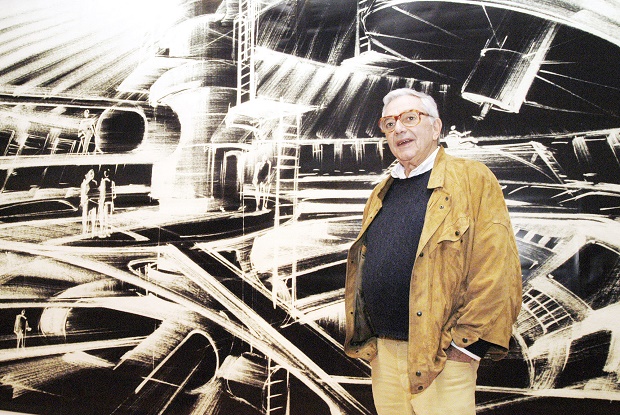‘Dr. Strangelove,’ Bond production designer Adam dies at 95

In this Oct. 31, 2002 file photo, German film designer Ken Adam stands in front of one of his futuristic designs at the exhibition “James Bond – Berlin – Hollywood” in the museum “Martin-Gropius-Bau” in Berlin. Adam died at the age of 95. His death was confirmed Thursday, March 10, 2016, by the official James Bond Twitter account. Adam’s death was first reported by the BBC, which said he died at his home in London. AP FILE PHOTO
NEW YORK — Ken Adam, the British production designer who gave “Dr. Strangelove” its cavernous War Room and James Bond supervillains their futuristic lairs, has died. He was 95.
Adam’s biographer, Christopher Frayling, said Adam passed away in his sleep Thursday at his home in London. Frayling called Adam “the greatest production designer for film, ever.”
MGM Studios and Eon Productions mourned the death of “our beloved friend” in a statement on the official James Bond Twitter account, hailing Adam as the person “who was so responsible for the visual style of the James Bond films.”
The Berlin-born Adam won two Academy Awards in a career that lasted into his 70s and spanned more than 70 films. He was revered for his indelible set artistry, including that for seven Bond movies. Adam was behind the Fort Knox vaults of “Goldfinger,” the iconic volcano hideaway of “You Only Live Twice” and Bond’s gadget-filled Aston Martin.
“One critic asked, ‘How did you ever get inside the volcano?'” Adam told the Los Angeles Times last year. “I didn’t get inside the volcano! I think that is the function of a film designer, to create something which the audience has never seen.”
In the art of production design, Adam’s work on Stanley Kubrick’s 1964 classic is widely considered among the craft’s highest achievements. His enormous, expressionistic set evoked a bomb shelter with a circular, lamp-lit table in the middle, designed to suggest a poker table. It was here where Peter Sellers famously chastised a tussling Air Force general and Russian ambassador: “Gentlemen, you can’t fight in here. This is the War Room!”
Adam was knighted in 2003, a first for a production designer.
Born Klaus Hugo Adam in 1921, Adam’s Jewish family fled Nazi Germany in 1934. They settled in London, where Adam became enraptured by German Expressionist films like “The Cabinet of Dr. Caligari.” He studied architecture, a background that would later prove useful for production design.
He volunteered during World War II and was one of only a handful of German-born pilots to fly for the Royal Air Force. Later, his flying experience would inspire the ejector seat of 007’s Aston Martin.
After the war, he was hired to assist veteran designer William Cameron Menzies (“Gone With the Wind”) on the Oscar-winning 1956 film “Around the World in 80 Days.” Adam caught the eye of producer Albert “Cubby” Broccoli who, after hiring him for “The Trials of Oscar Wilde,” enlisted a reluctant Adam for 1962’s “Dr. No,” the first Bond film.
Sets created by Adam – like the interior of the British Secret Service headquarters and Dr. No’s base – created a template for the franchise that would follow. He continued to be instrumental in crafting the iconic backdrops, props and torture devices that helped define the Bond world in “Goldfinger,” ”Thunderball,” ”You Only Live Twice,” ”Diamonds Are Forever” and “Moonraker.”
While Adam’s production design on Bond allowed his fantastical imagination to roam free, working with Kubrick was a more strained process.
After “Dr. Strangelove,” Adam turned Kubrick down for “2001: A Space Odyssey,” but he later reunited with the notoriously perfectionist director on “Barry Lyndon.” During shooting in Ireland, Adam was hospitalized because of the stress.
“I was incredibly close with him,” Adam told the BBC in 2013. “It was almost like an unhealthy love affair between us. And I had a breakdown eventually.”
Still, Adam won his first Oscar in 1976 for “Barry Lyndon,” which he shared with Vernon Dixon and Roy Walker. His second came in 1995 for “The Madness of King George,” which he shared with Carolyn Scott.
Other memorable inventions included the winged automobile of 1968’s “Chitty Chitty Bang Bang,” the gothic home of 1993’s “Addams Family Values” and the Cold War atmosphere of 1965’s “The Ipcress File.”
Adam is survived by his wife Maria Letizia, whom he married in 1952.